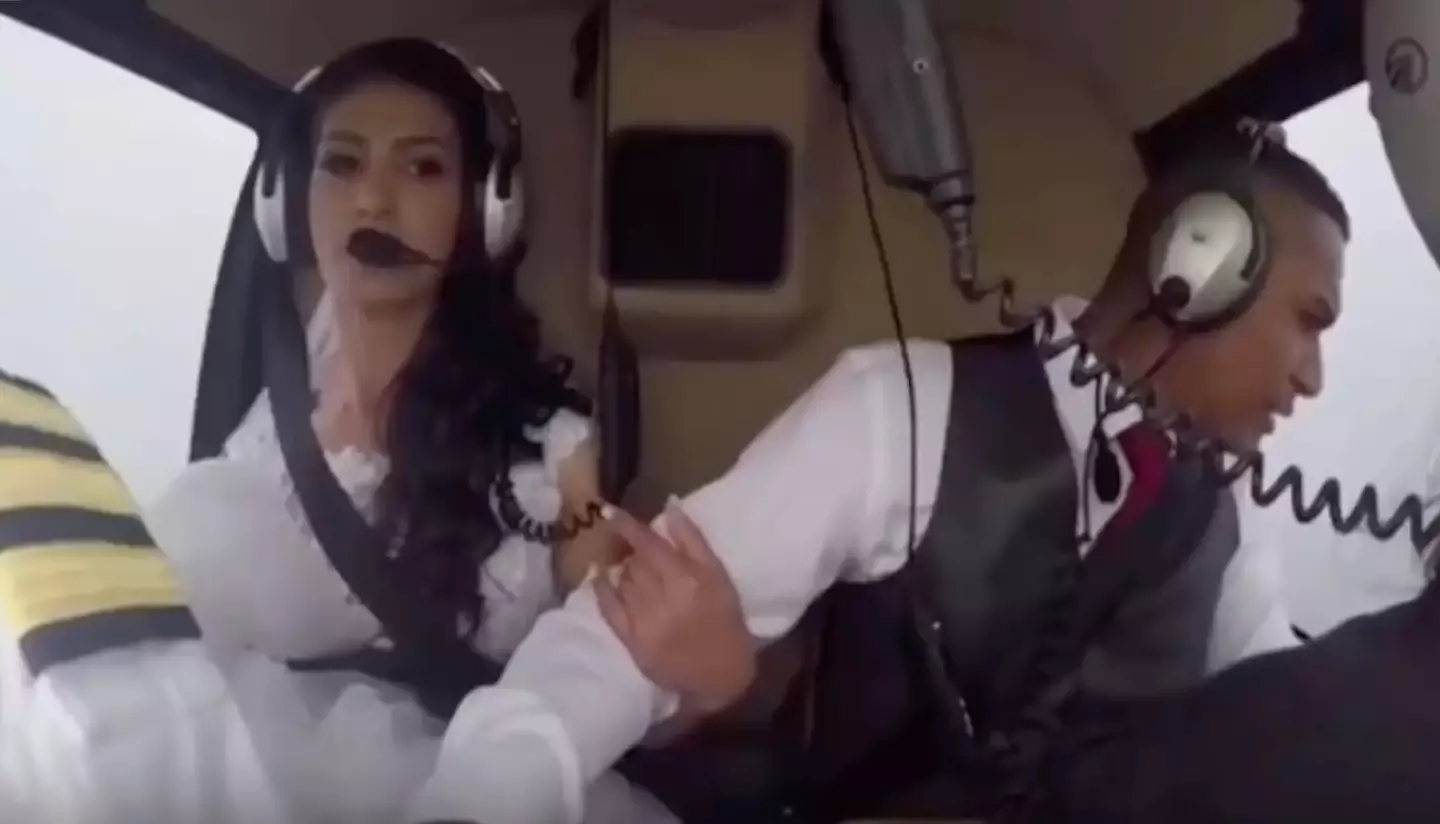In a heartbreaking turn of events that has left a community in mourning, tragic footage has emerged capturing the final moments of Rosemere do Nascimento Silva, a 32-year-old bride-to-be from São Paulo, Brazil. On the day of her wedding in December 2016, what should have been a magical entrance into her nuptials ended in catastrophe when the Robinson 44 helicopter she was riding in crashed just a mile away from the venue. This article offers an in-depth look at the fateful incident, the circumstances surrounding the crash, and the profound impact it had on the families and communities involved.
I. Introduction: A Dream Shattered in the Skies
Every bride dreams of a fairy-tale wedding day—a day filled with beauty, joy, and unforgettable moments. For Rosemere do Nascimento Silva, that dream was tragically cut short. Intended to be an unforgettable entrance, her plan to arrive by helicopter turned into a nightmare. As she was en route to celebrate her union with Udirley Damasceno, the aircraft succumbed to worsening weather conditions, ultimately crashing and claiming the lives of all onboard.
This story, captured on camera and later circulated on social media, provides a sobering reminder of how quickly joy can turn to sorrow, and underscores the importance of stringent aviation safety measures, especially in adverse weather conditions.
II. The Fateful Day: What Happened on That Tragic Morning
A. The Wedding Day Expectations
Rosemere, known for her vibrant spirit and meticulous attention to style, had planned every detail of her special day. In an effort to create a memorable entrance, she arranged for a Robinson 44 helicopter to carry her and her brother, Silvano Nascimento da Silva, to her wedding venue in Osasco—a charming party buffet known as Recanto Beija-Flor located in Greater São Paulo. With her groom, Udirley Damasceno, waiting at the altar, all eyes were set on a glamorous, once-in-a-lifetime arrival.
B. The Moment of Catastrophe
What unfolded was captured by cameras inside the helicopter, which had been recording what was meant to be a magical moment. The video shows a scene of celebration and anticipation as Rosemere and her brother smile and share light-hearted moments. It also includes brief shots of the pilot, Peterson Pinheiro, and photographer Nayla Cristina Neves—who, notably, was six months pregnant at the time.
Suddenly, amid the buoyant mood, the footage takes a drastic turn. In a matter of minutes, the helicopter becomes enveloped by fog as weather conditions deteriorate sharply. Alarms begin to ring out, and the jovial atmosphere quickly transforms into one of panic and confusion. In a tragic sequence, the aircraft loses stability and plummets to the ground. The crash, which occurred approximately 21 minutes after takeoff, resulted in a catastrophic impact that ended the lives of everyone on board.
C. Weather Conditions and Their Role
Meteorologists and crash investigators have pointed to the role of poor weather as a critical factor in the accident. Initially, when the helicopter took off around 4 p.m., the pilot reportedly enjoyed good visibility. However, within 21 minutes, the formation of dense fog and low-lying clouds dramatically reduced visibility. Rain and adverse weather are believed to have further complicated navigation, ultimately leading to the aircraft’s collision with nearby terrain—a tree and possibly other obstacles—which sealed the fate of everyone aboard.
III. Eyewitness Accounts and Official Statements
A. Eyewitness Reactions at the Wedding
The shock of the crash was palpable not only among the passengers and crew but also among those on the ground. Udirley Damasceno, the groom, waited in vain at the altar, unaware of the unfolding disaster. Meanwhile, the wedding organizer, Carlos Eduardo Batista, expressed his sorrow, remarking, “All brides have a dream, and hers was to arrive by helicopter to their wedding without anyone knowing.” His words reflect a profound loss, as the arrangements made to honor Rosemere’s unique vision ended in unimaginable tragedy.
B. Official Reactions and Investigations
Following the incident, Brazilian authorities, including the São Paulo police and aeronautical specialists, promptly launched an investigation into the crash. Preliminary findings suggest that the combination of poor visibility, rain, and fog contributed significantly to the accident. The wreckage, found in a forest area not far from the venue, confirmed that the helicopter had become unstable and crashed under the weight of adverse environmental conditions.
Officials released statements expressing deep sorrow for the loss of life and emphasizing the importance of rigorous safety protocols during flight, especially in rapidly changing weather. The investigation continues as authorities work to determine if any additional factors contributed to the tragedy.
C. Reflections on the Loss
For many, the resurfaced footage serves as a painful reminder of the fragility of life. Families of the victims, along with the broader community, are left grappling with grief, shock, and unanswered questions. The memory of Rosemere’s bright smile and hopeful demeanor now stands in stark contrast to the tragic final moments captured on film—a visual testament to a life filled with promise that was tragically cut short.
IV. The Broader Implications for Helicopter Safety and Event Planning
A. Reassessing Aviation Safety Protocols
The tragedy has prompted a closer look at the safety protocols surrounding helicopter travel, particularly for non-essential flights such as personal transport to events. Aviation experts suggest that while helicopters provide a unique and often glamorous mode of transport, they are also highly susceptible to unpredictable weather conditions. Key areas of focus include:
-
Pre-Flight Weather Assessments:
Enhancing the rigor of weather evaluations prior to takeoff, especially in regions known for rapidly changing conditions. -
Pilot Training:
Investing in advanced training for pilots to handle adverse weather conditions and unexpected visibility drops. -
Aircraft Maintenance and Technology:
Implementing cutting-edge technology such as real-time weather monitoring systems aboard aircraft to assist pilots in making swift, informed decisions.
B. Event Planning and Transportation Considerations
For event organizers and families planning similar arrivals:
-
Risk Assessment:
Consider the risks associated with unconventional modes of transportation. Weigh the desire for a dramatic entrance against the safety concerns that come with flight in potentially unstable weather. -
Alternative Arrangements:
Explore safer transportation alternatives, especially during seasons or in regions prone to sudden weather changes. Organizers should have contingency plans in place in the event that the primary mode of transport becomes unsafe. -
Communication Protocols:
Ensure that all parties involved—from the event planners to the passengers—are fully informed about potential risks and emergency procedures should something go awry.
C. The Role of Technology and Remote Monitoring
Advancements in aviation technology are rapidly evolving to enhance safety. Remote monitoring tools, satellite weather data, and improved communication systems can all contribute to safer flight operations. These innovations are critical for reducing the likelihood of similar tragedies in the future and ensuring that transportation, even for highly publicized events, meets stringent safety standards.
V. Media Response and Public Debate
A. Coverage by National and International Media
The tragic helicopter crash and the loss of Rosemere do Nascimento Silva have captivated media attention both in Brazil and internationally. News outlets across the globe have reported on the incident with a focus on the personal story of the bride who never made it to her wedding. In-depth analysis pieces have examined the sequence of events, the role of weather, and the potential for improving aviation safety protocols.
B. Opinions from Aviation Experts and Policy Makers
Aviation experts have weighed in on the incident, calling for tighter regulations and more robust emergency protocols. Policy makers in Brazil are now facing demands from the public and various stakeholders to review existing safety guidelines, particularly for private and non-commercial flights. The debate is centered on balancing the allure and convenience of helicopter travel with the necessity for uncompromised safety standards.
C. The Emotional Impact on the Public
The footage of Rosemere’s final moments has provoked strong emotional responses. Social media platforms have become a space for public mourning, with heartfelt tributes poured out by fans and colleagues of the victims. Many have expressed a deep sense of loss and shock, emphasizing the preciousness of life and the need for greater safety measures in all aspects of travel.
VI. Reflections on Tragedy and the Human Spirit
A. Personal Stories and Family Impact
For the families directly affected by this tragedy, the loss is immeasurable. The groom, Udirley Damasceno, and the family of Rosemere now face a future forever altered by grief and sorrow. The wedding, once anticipated as a celebration of love and new beginnings, has become a somber memory. In the days and weeks following the accident, family members and friends have struggled to come to terms with the loss, sharing memories of Rosemere’s kindness, joy, and the dreams she once held.
B. The Importance of Remembering and Honoring the Lost
In the aftermath of such a devastating event, communities often come together to remember and honor the lives that were lost. Vigils, memorial services, and online tributes have all played a role in helping people process their grief. These acts of remembrance serve not only as a means of healing but also as a call to action for improved safety and awareness to prevent future tragedies.
C. Finding Hope Amid Loss
While the loss of Rosemere do Nascimento Silva is a profound tragedy, her story also serves as a powerful reminder of the importance of cherishing every moment. In the face of overwhelming loss, many find solace in the memories of the joyous times shared with loved ones. For those affected by this incident, finding hope and resilience in the midst of sorrow is a difficult yet essential journey—a journey that speaks to the enduring strength of the human spirit.

The bride’s final moments were caught on camera (X)
VII. Steps Forward: Enhancing Safety and Preventing Future Tragedies
A. Improving Aviation Safety Measures
A primary lesson from this tragic incident is the critical need for enhanced aviation safety protocols:
-
Stricter Weather Monitoring:
Implementing real-time weather updates and more stringent criteria for safe flight conditions, particularly during critical operations such as wedding arrivals. -
Enhanced Pilot Training:
Ensuring that pilots are equipped with advanced training to handle sudden weather changes and emergency scenarios. -
Upgraded Aircraft Safety Systems:
Investing in the latest technology for navigation, communication, and emergency management to minimize risks during adverse conditions.
B. Recommendations for Event Organizers and Families
For those planning events that involve unique transportation methods:
-
Risk Assessment and Contingency Planning:
Thoroughly evaluate all potential risks associated with the chosen mode of transport. Develop comprehensive contingency plans that address worst-case scenarios. -
Clear Communication:
Maintain open lines of communication with all parties involved—from the pilots to the ground crew. Ensure that everyone is aware of emergency protocols. -
Prioritize Safety Over Spectacle:
While a dramatic entrance can create lasting memories, it should never come at the cost of safety. Choosing the safest option available is paramount.
C. Community and Government Initiatives
Local authorities and community leaders also have a role to play in preventing future tragedies:
-
Reviewing and Strengthening Regulations:
Government bodies must revisit current aviation regulations, especially for private and chartered flights, to enforce higher safety standards. -
Investing in Infrastructure:
Expanding or upgrading facilities such as helipads and emergency response centers to better support safe flight operations. -
Public Awareness Campaigns:
Raising awareness about the risks associated with adverse weather conditions and promoting a culture of safety among private aviation operators and the public at large.
VIII. Final Thoughts: Honoring a Life and Learning from Loss
The heartbreaking story of Rosemere do Nascimento Silva is a stark reminder that even the most well-planned events can be tragically disrupted by forces beyond our control. As the evidence in the resurgent footage painfully illustrates, what should have been a dream wedding turned into a moment of irreversible loss. For the community, for the families, and for the world of aviation, this incident stands as a call to action—a reminder of the continuous need for vigilance, innovation, and a steadfast commitment to safety.
The legacy of Rosemere, forever imprinted in the memories of her loved ones and the community she was poised to join, now serves to inspire change. Her untimely death pushes us to re-examine our safety protocols and to honor each life by protecting the lives of those yet to come. As we move forward, let this tragedy serve as a catalyst for better regulation, more responsible event planning, and a united dedication to ensuring that no life is needlessly lost.
May Rosemere do Nascimento Silva be remembered not only for her beauty and the promise of her love but also as a poignant reminder of the precious fragility of life. Through ongoing efforts to improve safety and through our collective resolve, we can help prevent such tragedies and honor the memory of those who have been taken too soon.

